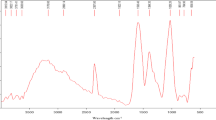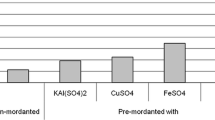Abstract
Application of naturally dyed fabrics is increasing due to the biological protection, pollution control, ecology and improved quality of life of human beings. Antimicrobial textiles can be the best choice to avoid fabric related infection. Many plants have been regarded as suitable for extraction of natural dyes that can also show good antibacterial activity. However, in this work, natural dye from pomegranate peel was extracted by ultrasonic method and then lyocell fabrics were treated with different mordanting agents. Afterwards, mordanted fabric samples were dyed by exhaust dyeing. Dyed samples were analyzed with rubbing, washing, perspiration and light exposure tests for color fastness. The results revealed that different types of mordants have dissimilar effects on color efficiency and color range values of dyed lyocell fabrics. The dyed fabric with different mordants showed excellent color strength (K/S) values (6.4) and color fastness properties of washing (4–5), light (5–6), rubbing (4–5) and perspiration (4–5). Furthermore, FTIR confirmed that no structural change occurred in the lyocell fabric before and after the dyeing process. Additionally, antimicrobial properties of un-dyed and dyed with pomegranate peel were assessed against Staphylococcus aureus (ATCC® 25923™) by the agar diffusion test method. The obtained antimicrobial activities of the samples dyed with pomegranate peel were compared with that of the un-dyed samples. The un-dyed samples displayed slight antibacterial properties while fabrics dyed with pomegranate peel exhibited suitable antibacterial properties. Thus, lyocell fabrics dyed with pomegranate peel are useful for biomedical applications.




Similar content being viewed by others
References
Adeel S, Ali S, Bhatti IA, Zsila F (2009) Dyeing of cotton fabric using pomegranate (Punica granatum) aqueous extract. Asian J Chem 21:3493
Adhami VM, Khan N, Mukhtar H (2009) Cancer chemoprevention by pomegranate: laboratory and clinical evidence. Nutr Cancer 61:811–815
Al-Zoreky N (2009) Antimicrobial activity of pomegranate (Punica granatum L.) fruit peels. Int J Food Microbiol 134:244–248
Babar AA, Peerzada MH, Jhatial AK, Bughio NU (2017) Pad ultrasonic batch dyeing of causticized lyocell fabric with reactive dyes. Ultrason Sonochem 34:993–999. https://doi.org/10.1016/j.ultsonch.2016.07.018
Carrillo F, Colom X, Suñol JJ, Saurina J (2004) Structural FTIR analysis and thermal characterisation of lyocell and viscose-type fibres. Eur Polym J 40:2229–2234. https://doi.org/10.1016/j.eurpolymj.2004.05.003
Davulcu A, Benli H, Şen Y, Bahtiyari Mİ (2014) Dyeing of cotton with thyme and pomegranate peel. Cellulose 21:4671–4680. https://doi.org/10.1007/s10570-014-0427-8
Goodarzian H, Ekrami E (2010) Wool dyeing with extracted dye from pomegranate (Punica granatum L.) peel. World Appl Sci J 8:1387–1389
Gupta D, Khare SK, Laha A (2004) Antimicrobial properties of natural dyes against Gram-negative bacteria. Color Technol 120:167–171
Ibrahim N, El-Gamal A, Gouda M, Mahrous F (2010) A new approach for natural dyeing and functional finishing of cotton cellulose. Carbohydr Polym 82:1205–1211
Ismail T, Sestili P, Akhtar S (2012) Pomegranate peel and fruit extracts: a review of potential anti-inflammatory and anti-infective effects. J Ethnopharmacol 143:397–405
ISO 105-X12 (2001) Textiles–tests for color fastness. Part X12: color fastness to rubbing: test 1 (France: 2001)
ISO 105-C10 (2006) Textiles–tests for color fastness. Part C10: color fastness to washing: test 1 (France: 2006)
ISO 105-E04 (2008) Textiles–tests for color fastness. Part E04: color fastness to perspiration: Test 1 (France: 2008)
ISO 105-B02 (2014) Textiles–tests for color fastness. Part B02: color fastness to artificial light (Geneva: ISO 1994)
Kim ND et al (2002) Chemopreventive and adjuvant therapeutic potential of pomegranate (Punica granatum) for human breast cancer. Breast Cancer Res Treat 71:203–217
Kulkarni S, Gokhale A, Bodake U, Pathade G (2011) Cotton dyeing with natural dye extracted from pomegranate (Punica granatum) Peel. Univ J Environ Res Technol 1:135–139
Lansky EP, Newman RA (2007) Punica granatum (pomegranate) and its potential for prevention and treatment of inflammation and cancer. J Ethnopharmacol 109:177–206
Lee Y-H, Hwang E-K, Kim H-D (2009) Colorimetric assay and antibacterial activity of cotton, silk, and wool fabrics dyed with peony, pomegranate, clove, coptis chinenis and gallnut extracts. Materials 2:10–21
Mahmood MA, Al-Dhaher ZA, AL-Mizraqchi AS (2010) Antimicrobial activity of aqueous extracts of pomegranate, sumac, sage, anise, hand bull tongue, thyme, cloves, lemon and mint against some food-borne pathogens. Iraqi J Vet Med 34(2):85–94
Malviya S, Jha A, Hettiarachchy N (2014) Antioxidant and antibacterial potential of pomegranate peel extracts. J Food Sci Technol 51:4132–4137
McDonald R (1997) Colour physics for industry. The Society of Dyers and Colourists
Negi P, Jayaprakasha G (2003) Antioxidant and antibacterial activities of Punica granatum peel extracts. J Food Sci 68:1473–1477
Onar N, Aksit A, Sen Y, Mutlu M (2011) Antimicrobial, UV-protective and self-cleaning properties of cotton fabrics coated by dip-coating and solvothermal coating methods. Fibers Polym 12:461–470
Prashanth D, Asha M, Amit A (2001) Antibacterial activity of Punica granatum. Fitoterapia 72:171–173
Prusty A, Das T, Nayak A, Das N (2010) Colourimetric analysis and antimicrobial study of natural dyes and dyed silk. J Clean Prod 18:1750–1756
Sanbhal N, Mao Y, Sun G, Li Y, Peerzada M, Wang L (2018a) Preparation and characterization of antibacterial polypropylene meshes with covalently incorporated β-cyclodextrins and captured antimicrobial agent for hernia repair. Polymers 10:58. https://doi.org/10.3390/polym10010058
Sanbhal N, Mao Y, Sun G, Xu RF, Zhang Q, Wang L (2018b) Surface modification of polypropylene mesh devices with cyclodextrin via cold plasma for hernia repair: characterization and antibacterial properties. Appl Surf Sci 439:749–759. https://doi.org/10.1016/j.apsusc.2017.12.192
Simoncic B, Tomsic B (2010) Structures of novel antimicrobial agents for textiles: a review. Text Res J 80:1721–1737
Singh R, Jain A, Panwar S, Gupta D, Khare S (2005) Antimicrobial activity of some natural dyes. Dyes Pigments 66:99–102
Sun G (2011) Antibacterial textile materials for medical applications, pp 360–375. https://doi.org/10.1533/9780857092878.360
Zhang Z, Tang J, Wang H, Xia Q, Xu S, Han CC (2015) Controlled antibiotics release system through simple blended electrospun fibers for sustained antibacterial effects. ACS Appl Mater Interfaces 7:26400–26404
Acknowledgments
The research was supported by the Fundamental Research Funds for the Central Universities (No. 17D310503) and National Natural Science Foundation of China (No. 51403032).
Author information
Authors and Affiliations
Corresponding author
Ethics declarations
Conflict of interest
The authors declare that they have no conflict of interest.
Rights and permissions
About this article
Cite this article
Rehman, F., Sanbhal, N., Naveed, T. et al. Antibacterial performance of Tencel fabric dyed with pomegranate peel extracted via ultrasonic method. Cellulose 25, 4251–4260 (2018). https://doi.org/10.1007/s10570-018-1864-6
Received:
Accepted:
Published:
Issue Date:
DOI: https://doi.org/10.1007/s10570-018-1864-6




